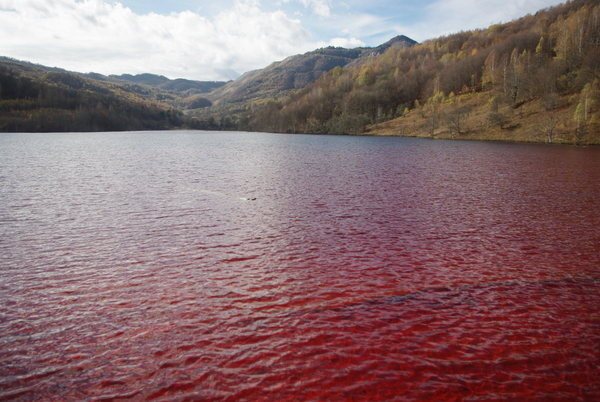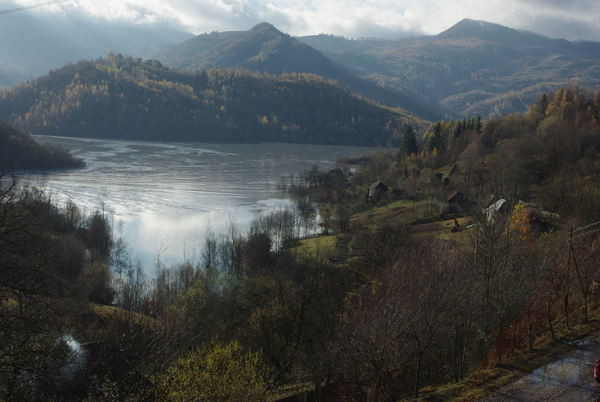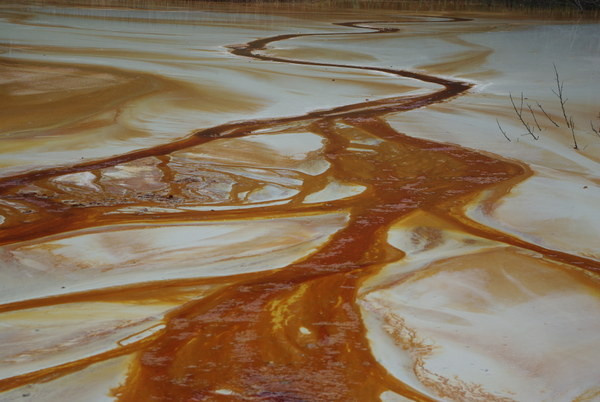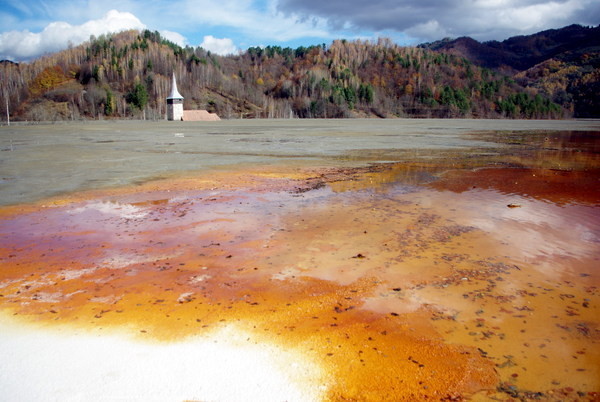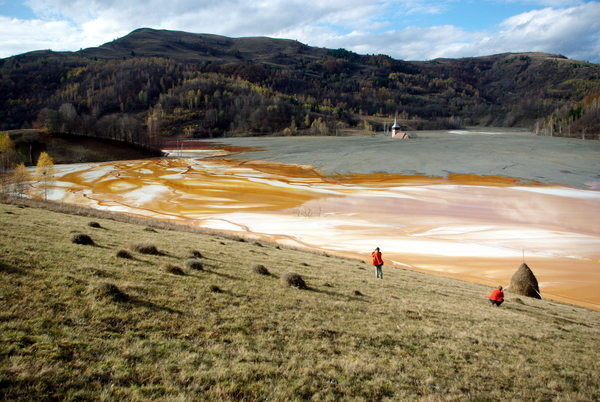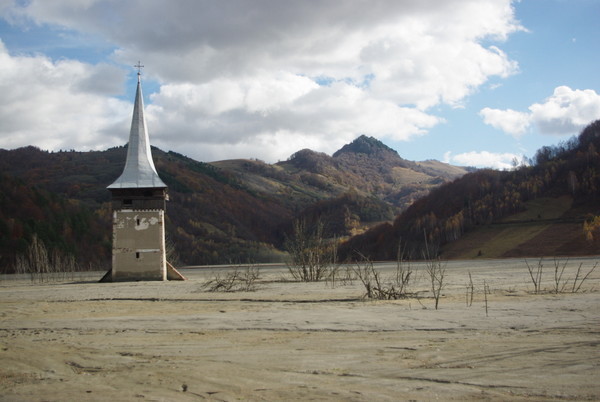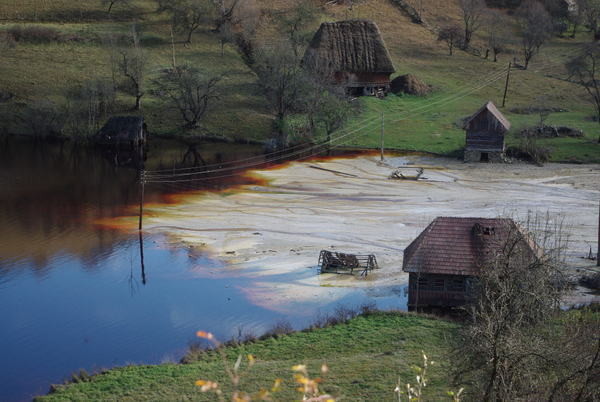Photos via Bogdan Balaban
Remember that time thousands of dead birds fell out of the sky above Arkansas? Well, nature is back on the warparth. In May, reports emerged of thousands of dead fish floating along the Arieş River in Romania. The explanation the local administration came up with was that the fish had died from asphyxiation, caused by the mud brought in by heavy rains in the area. However, local NGOs have good reason to suspect that it was humans who caused the calamity, not a bit of rain churning up mud at the bottom of the river.
Videos by VICE
This isn’t the first time the Arieş has suffered. There is an artificial lake in the nearby town of Valea Șesii, and many say that it is often to blame for the Arieş’s problems. Or rather, the Cuprumin Company, owner of the nearby Roşia Poieni copper mine, is to blame, as it seems to be dumping all of its waste into said lake.
In 1999, several thousand cubic meters of water and sludge containing cyanide and heavy metals were released from the Baia de Aries gold mine into the Arieș River. All the fish died and the drinking-water supply for the nearby city of Turda was disrupted. In 2004, all plant and animal life in the Arieş River mystically perished.
In 2008, millions of dead fish floated along the river for three days because Cuprumin had forgotten to charge the electric pumps that protected the area from biohazards. In 2011, a pipe broke and 100 tons of waste poured into the Curmătura River before making its way into the Arieș River. Finally, last year a few mineshafts were flooded, which caused the red water to spill into the Arieș. However, no dead fish were reported. Every year, Cuprumin receives fines from the local authorities, yet these are obviously minor compared to the damage and don’t seem to be having much, if any, effect whatsoever.
To find out more about the latest accident and what the authorities plan to do about it, I called up Tudor Brădățan, a member of the Independent Center of Resource Development, which is based in the Cluj region and works with a lot of environmental NGOs. Their latest project is focused on forming a large web of organizations that could monitor the rights of mines as well as their legality.
(Left) The acid water reaches the Arieș. (Right) The area between the town of Moldovenești and the border with the next county, Alba, where the dead fish were found. (Top) A larger view of the area. Map by Liminița Dejeu, a member of rosiamontana.org
VICE: Hi, Tudor. What do you think actually happened to the Arieș on May 31?
Tudor Brădățan: The authorities said that only fish smaller than 15 centimeters were found dead, and there was no proof of water pollution. However Marius Mașca, from the Potaissa Hunter’s Association in Turda believes they found four tons of dead fish belonging to four different species, for a distance of several kilometers upstream from Turda. He came up with this number after estimating the quantity of dead fish from one part of the river and multiplying it by the affected portion of the river. Repopulating the river will take years.
Why do you believe the fish were poisoned and not asphyxiated?
Portions of rivers which are only temporarily covered by mud can not affect such a large amount of fish; the water dilutes. Besides, if so much muddy water came from every hill near the Arieș, it would have caused severe damage to the nearby area. It’s suspicious that so many fish died from asphyxiation in an area surrounded by toxic waste dumps and pipes filled with acid.
It certainly is suspicious. Are there other factors?
Between the counties of Cluj and Alba there are lots of both closed and operational mines, which pollute the nearby waters.
Interesting.
Why don’t the fish in other rivers asphyxiate when it rains?
Some people collected the dead fish and sold them for food. Is that dangerous?
Under no circumstances should you eat these fish. Unfortunately, if you’re hungry and can’t afford anything better, then the temptation might be too great. The fish could be contaminated, and whatever killed it might kill you. The authorities are covering up an environmental accident and you could have been eating chemically altered fish.
In your opinion, what are the odds that this accident was caused by waste leaks from the Valea Șesii Lake?
The lake, which is actually a giant crater surrounded by a dam, is where waste produced by the Roșia Poieni copper mine is dumped. In the past there have been some examples of bad administration there. As the lake grows, houses from the former village of Geamăna are gobbled up by the toxic mud. Even if the authorities say these fish died from natural causes, I don’t think any institution actually did a field study to see if there’s a leak. They just took some water samples a long time after the dead fish were spotted, and no traces of pollution were found. But by the time the water reaches Târgu Mureș, it’s already pretty diluted.
Have the authorities been helpful at all?
Communicating with the authorities from Alba is very hard—no environmental institution gives us any information. No complete report that documents the biohazards in this area was ever made. They’re basically still following the old Communist system, where environmental accidents are never carefully investigated or punished. Cuprumin is always being disbanded and bought in complicated schemes, which only the politicians can understand. A few years ago the World Bank financed a project through which several maintenance works were done on the artificial lake, but there are other, older mining operations on which nobody is doing any repairs. The mining companies propose that the environmental disasters left to the current generation by the Romanian state should be solved with the reopening of the mining shafts.
What action are you taking?
We’re planning to make a guide for all the fishermen and those who find dead fish in the area. It will contain the methodology of taking samples, what authorities you have to call, and the cleanup process that should follow. We want to have specialists test the authorities’ implausible answers and offer them some conclusive samples taken right after the dead fish show up.
Why do you think the authorities want to cover up the pollution?
The state has been trying to sell the Cuprumin Company for a long time now. Several irregularities have been noticed and included in the motion which brought down last year’s government. Varujan Vosganian, the current Minister of the Economy, says that the process of selling the company continues. The authorities hope that a serious company will buy Cuprumin and they’ll invest in restoring the environment and waste their profit on this when they have no obligation to do anything. As these contracts are secret we can never tell if Vosganian acts on the interest of the people, who have a right to a clean environment, or that of the mining companies. Under these circumstances making an accident from that area near the Roșia Poieni Mine a popular subject wouldn’t help those with financial interests in the area, who care less about the people living there.
Thanks!
More stuff about gross water:
Watch – Toxic: Garbage Island
Watch – America’s Water Crisis
